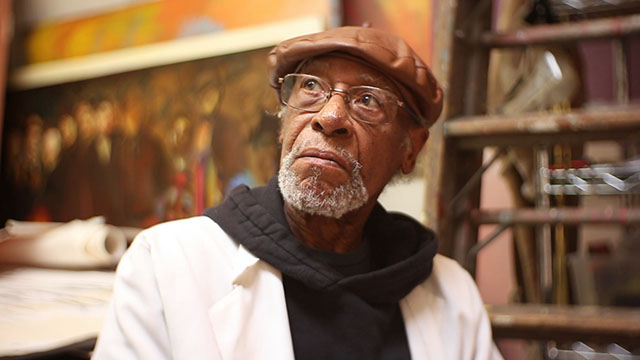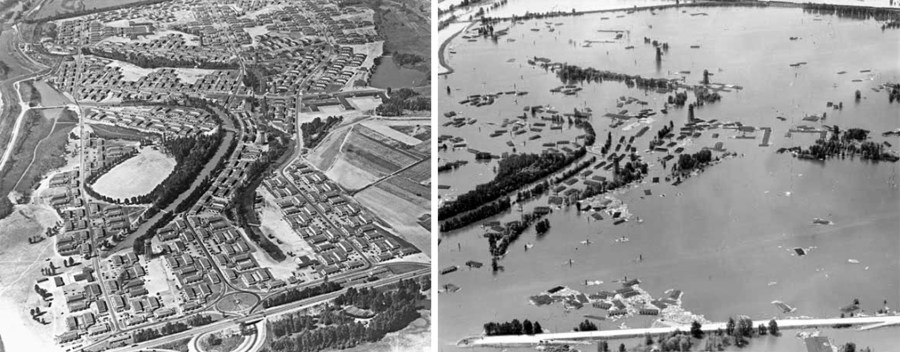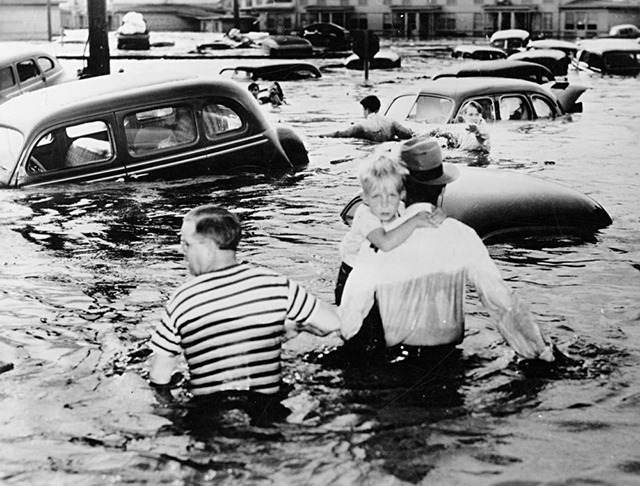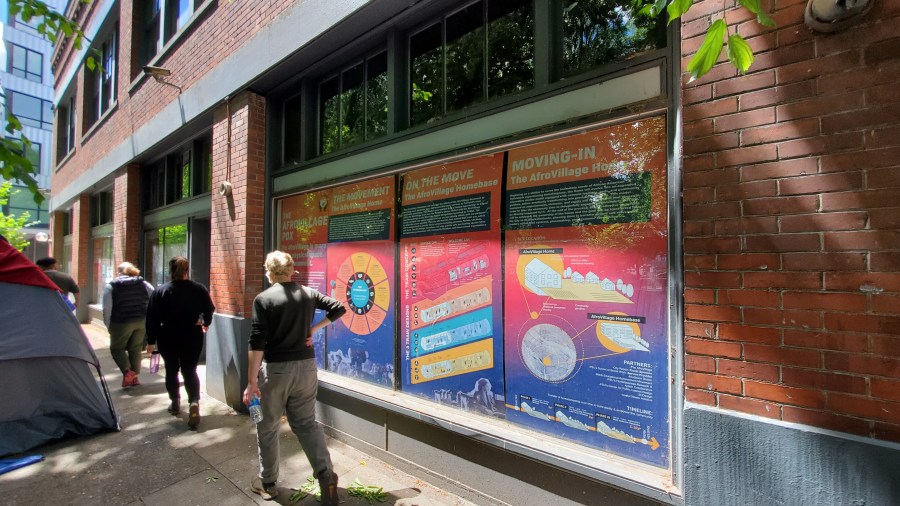PORTLAND, Ore. (KOIN) — This week marks the anniversary of the 1948 Vanport flood, an event that killed 15 people and displaced thousands of others from a culturally diverse city that was built in what is modern-day Northeast Portland near Delta Park and the Portland International Raceway.
Now, for the first time in 73 years, Portland’s housing authority, Home Forward, is acknowledging the mishandling of their flood response.
But a survivor of the flood, artist Isaka Shamsud-Din, said the apology bears no meaning without reparations for the economic and emotional trauma the event caused to families like his, who were displaced without any notice of evacuation or help securing housing afterwards. The city gave notice to residents saying there was no immediate danger hours prior to the flood, but cleared out its own offices in anticipation of a nearby stressed dyke holding back water.

“It’s meaningless,” Shamsud-Din said of the recent apology. “It’s actually a very high, high level insult, the highest level, if there’s no reparations. Because we lost everything. And it set the course for the breakup of our family and I don’t know how many others. But it was devastating to the degree that it is living, it’s live with me, it burns every single day of my life. And it has since.”
Vanport was once Oregon’s second largest city built in 1942 to accommodate Black and poor shipyard workers moving to the greater Portland area during World War II. At its peak, it housed 40,000, and became the country’s largest housing project at the time.
On Sunday, May 30, the anniversary day of the flood, Home Forward’s Executive Director, Michael Buonocore posted a video on the organization’s Twitter page to formerly acknowledge and apologize for then-Housing Authority of Portland’s (HAP) role in not doing more to help people evacuate and secure them housing afterward, among other things.
“By 1948 we had allowed Vanport to fall into disrepair. It was considered an eyesore and a slum. Black people weren’t the only people living there, but they were a high percentage of the population because there was really nowhere else for them to go,” Buonocore said, referencing the fact that Black people in Portland had already been segregated in the redlined area of Albina even before Vanport was built.
“That spring, as the likelihood of flooding increased, local officials and HAP downplayed the threat of disaster. We put notes on people’s doors that said ‘remember: dikes are safe at present. You will be warned if necessary. You will have time to leave. Don’t get excited.’”

Despite the notice, the housing authority itself “got a little excited” and removed files and horses from its property, but didn’t evacuate the people, Buonocore said.
Shamsud-Din said he remembers waking up on the morning of May 30 seeing the note that had been slipped under the door of his family’s home when he was just seven years old. Hours later, in the afternoon of Memorial Day 1948, the flood devastated the community. Shamsud-Din said he thinks the warning was given “to trick us into waiting long enough to make sure we got wiped out.“
“HAP did not help the Black residents of Vanport relocate to other housing throughout the city. Instead, we reinforced their isolation and segregation. Albina was still the only area where Black people could live, but there wasn’t enough housing to accommodate them. And what we really wanted was for Black people to leave,” Buonocore said.
Story continue below.
Buonocore went on to say that from its earliest days, like many institutions in the U.S., HAP worked to reinforce the progress of white people at the expense of Black, brown, Indigenous and people of color communities.
“On behalf of Home Forward, I want to acknowledge the racism, the negligence and wrongdoing in the lease up, management and maintenance of Vanport, for the lack of care and concern for the livelihood of the people who lived there and the way we treated people, especially the Black community, in the aftermath of the flood,” he said. “We were wrong. And I apologize to the community and to the people who were hurt.”
Buonocore said from the beginning, Portland officials wanted nothing to do with Vanport, but the people moving into the area to work at the shipyards had nowhere to go.

So, Edgar Kaiser built Vanport in 110 days, circumventing local officials’ resistance to its existence. HAP then took over its operations out of necessity. But the city wasn’t designed for longevity, with homes being built on non-permanent foundations. Eventually heavy rainfall and a melting snowpack stressed a nearby dyke to burst in spring 1948.
The entire city was destroyed in less than a day, displacing 18,500 people, including roughly 6,300 Black residents, according to Smithsonian Magazine.
Shamsud-Din came to be aware that city organizations began evacuating their offices prior to that fateful day after researching as part of a work study in the mid-1960s while attending what was then Portland State College, now known as Portland State University (before then, the college was called the Vanport Extension Center and located within the city of Vanport).
“I was looking through the old [school newspaper] Vanguards…and I saw where they were evacuating Vanport Extension Center or Vanport college weeks before we got that notice,” he said.
Shamsud-Din said the event tainted his childhood and growing up, with his family having to go on welfare for several years after previously not being on any assistance.
“A lot of what happened to a lot of people were reverberations from that flood, from the way that was done.“
Shamsud-Din said his first mural and two others were about the Vanport flood trying to make sense out of what happened.
To commemorate the tragedy, and other lost histories of underrepresented groups in Oregon, a series of “memory activism” events are occurring in Portland for a yearly festival known as Vanport Mosaic Festival.

That includes a “History is Now” outdoor exhibit, in collaboration with a national collective known as Design As Protest, utilizing empty storefront windows with history displays that celebrate local communities’ strength and meant to inspire people to join in solidarity and action, according to organizers. The pop-up exhibit is currently up and consists of 65 displays spreading across six buildings in the North Park Blocks. Those displays can be found in the buildings at the intersections for NW Flanders and Park, NW Flanders and Everett, and NW Park and Couch. The displays will be up from now until at least June 30.
A public gathering and place-claiming action is planned for Sunday, June 6, from Noon to 1pm at the North Park Blocks.
The festival, now in its 6th year, will culminate with the “We The People” weekend June 26-27 at North Park Blocks with live music, intergenerational dialogues, poetry, vendors, a Zine Machine distributing free memory activism resources, and a Community Procession/Second Line.
Laura Lo Forti, the co-founder and co-director of Vanport Mosaic, the non-profit that runs the yearly festival, said it is a platform or collective for intentionally remembering erased histories.
“Our belief is that stories are intentionally erased from official records and from our memories. And so we intentionally remember. So that’s what memory activism is,” she said. “As an organization, as a collective, we amplify, honor, present, and preserve the many silenced histories that surround us.”
